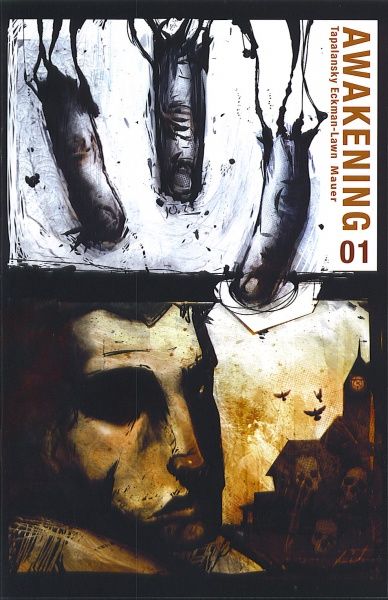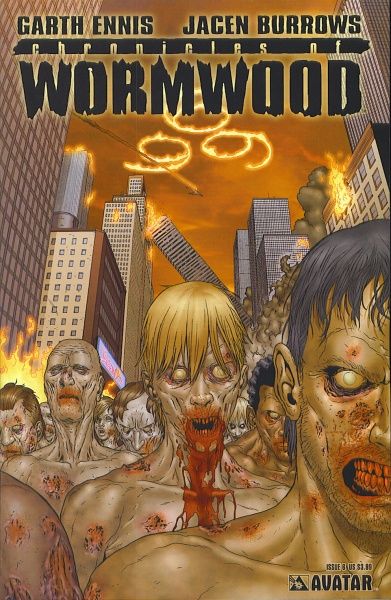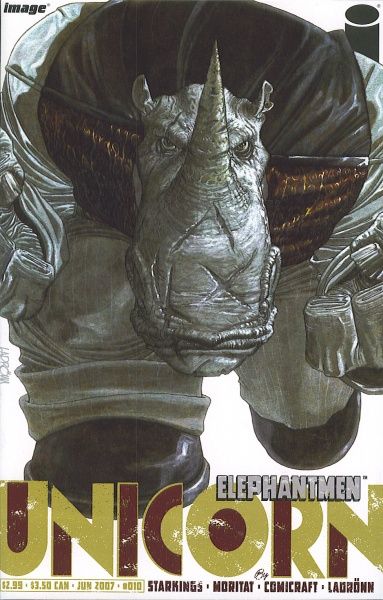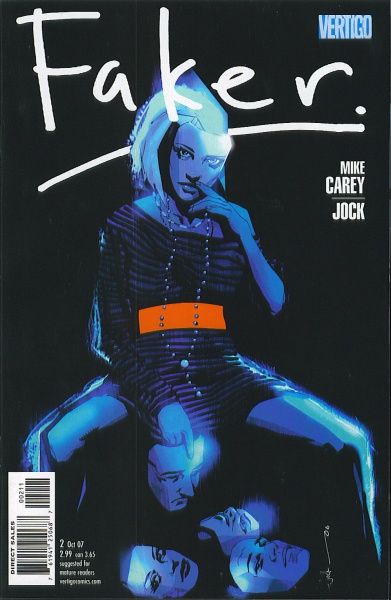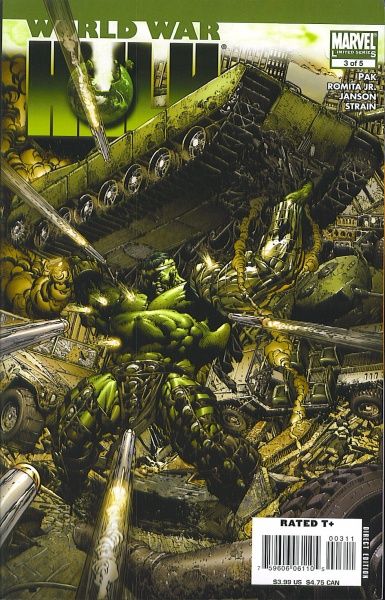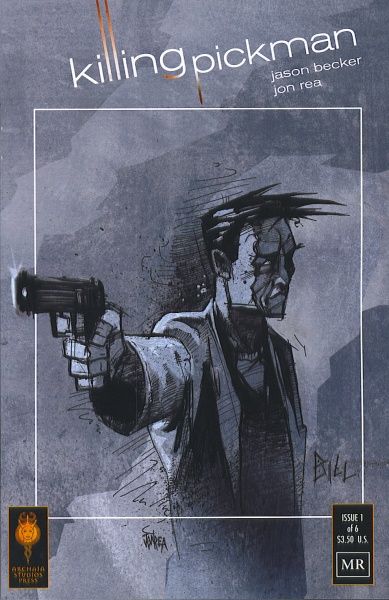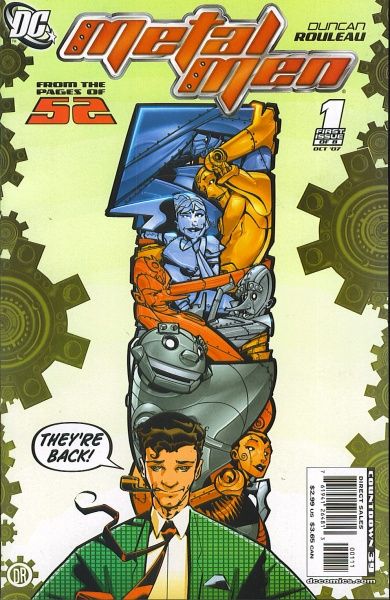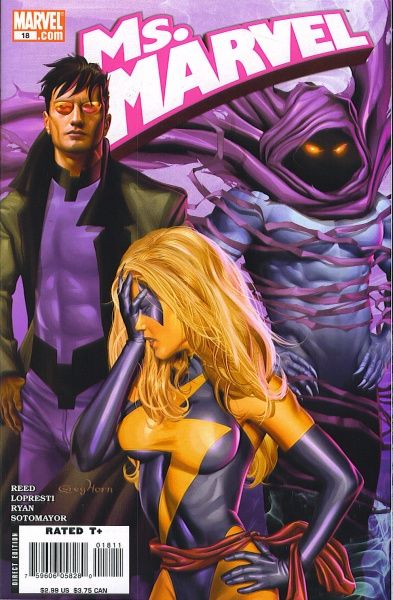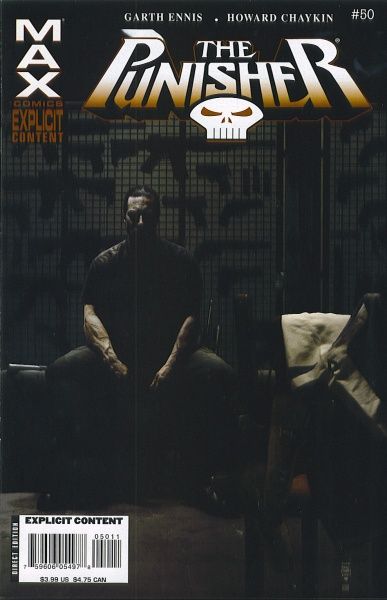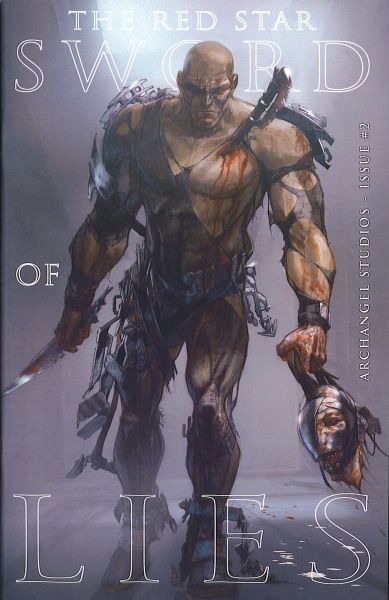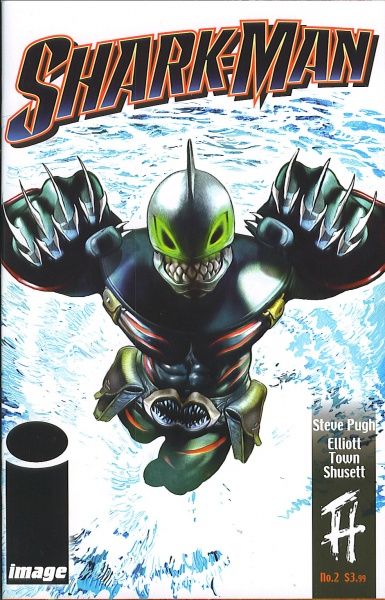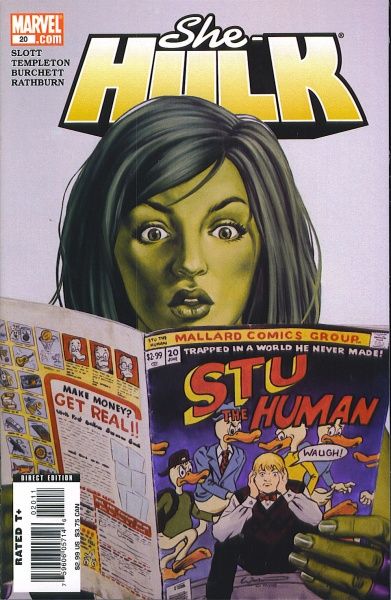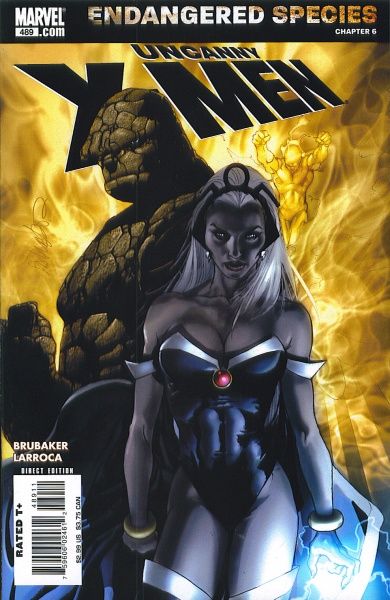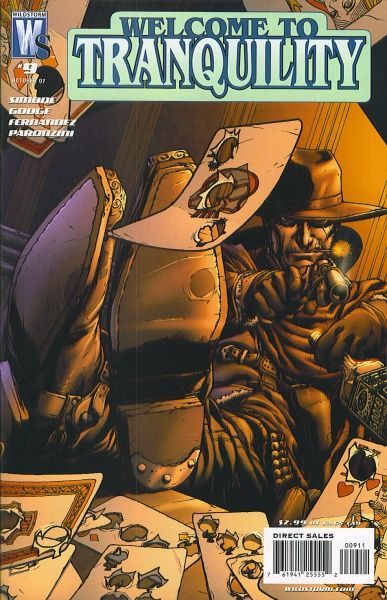Sorry this is late this week. The last two days have been hectic, to say the least. But whereelse can you findthe greatest comics reviews on the Internet? Well, I suppose a lot of other places. But I have to have some merit, right? Right?
Awakening #1 by Nick Tapalansky and Alex Eckman-Lawn. $3.50, Archaia Studios Press.
When this book was solicited, Tapalansky came on the blog and promised that it wasn't necessarily a zombie book. Well, I hope not, because all the signs point that way! There's nothing inherently wrong with a zombie book, although they're not really my thing. If they're done well, that's fine. And in this book, there's certainly something else going on, because there's a sinister pharmaceutical company lurking in the background, and we all know pharmaceutical companies are way evil, right?
So that's the set-up. In the city of Park Falls, things are eating people. The Feds are called in, an ex-cop gets a visit from a local crazy woman who claims the things are zombies, and there's a dark mystery behind it. Tapalansky hits all the notes you would expect him to, and it's not a bad set-up, but it feels like a pretty standard monster book. That's not to say there won't be twists and turns along the way, but it doesn't feel like it will stand out. If you're a fan of the genre, it's not a bad book by any means, but it doesn't rise above that and become something more interesting. Eckman-Lawn's art is an odd mixture of what looks like century-old photography (which helps add to the weirdness of the town and the winter setting) and very rough linework, which makes the drawn figures look like woodcuts. It establishes the mood well, but doesn't add much more.
Obviously I wish the creators luck with this, but it's not really my cup of tea. Even if it's not zombies.
Chronicles of Wormwood #6 (of 6) by Garth Ennis and Jacen Burrows. $3.99, Avatar.
I'm not entirely sure if this mini-series was worth 4 bucks an issue, but it does show why I like Ennis so much - he's really an old softie who just wants to sit in a bar with his friends drinking. There's nothing wrong with that!
Everything works out kind of how we expect it to, as Danny confronts his father and God and Jay makes a heart-wrenching experience. One thing Ennis does extremely well is write sincere conversations between friends, and that's what we get here, as Danny has to convince Jay that he doesn't really want to die. That's really the crux of Ennis' religious beliefs, it seems - we don't need God and Satan, and all we really need to do is be decent to each other. Danny's speech to Jay is perfect because it really does sum up what Christianity ought to be but isn't. It's a charming way to end the series, but again, I'm not sure it's worth the money to get there.
Burrows' art is certainly worth it, even though he doesn't have a lot to do here. He does get to draw a harrowing version of Hell on Earth, so I guess that's something.
I'm not saying this is a bad comic, but it's a bit pricey. I assume a trade is coming out soon, and if you can get it a bit cheaper, it's certainly an interesting comic to read.
Elephantmen #10 by Richard Starkings and Moritat. $2.99, Image.
Well, another issue, and another excellent one. Like a few books I buy, it's very difficult to praise this comic in a different manner each time it comes out. This is a wonderful look at Obadiah Horn, the rhino Elephantman, who has become a ruthless businessman after his liberation. In this issue, we learn that extinct black rhinos have been re-created by the same doctor who created the Elephantmen, and the organizations that Obadiah helps with charity has given him two of them. Obadiah runs with the rhinos and remembers his life as a soldier, when he realized that he never wanted to be "human" and feels more at home with the rhinos. We also get more insight into his relationship with Sahara, the only person who didn't look at him as if he was a monster. As usual with the book, the characters drive the action, and just when we're ready to believe that Obadiah isn't a complete bastard, he does something that confirms that he is. But that's what's great about this book - Obadiah can do despicable things yet still treat Sahara with tenderness, and we buy it because Starkings has done such a nice job in a limited time in making the personalities real. Moritat, whose art is always nice, really shines in this issue, both with the savanna on which Obadiah runs with the rhinos, but in the flashbacks to Obadiah's experience on the battlefield. It's a majestic-looking book.
I got this last week at the Con, but it's been out for a few weeks. If you've been waiting for the trade on this title, the hardcover just came out this past week. It's definitely worth it, because this is a great comic book.
Faker #2 (of 6) by Mike Carey and Jock. $2.99, DC/Vertigo.
I'm torn. I wasn't completely sold on the first issue of this book because the characters were just so unpleasant. It was an intriguing premise and the art was good, so I checked out the second issue. The characters are only slightly less unpleasant, even though I still loathe Jessie, and the premise is more intriguing, but I'm still not sold. For one thing, Carey makes some nice pronouncements about how we live and how our friends don't always tell the truth, and it's a nice moment except for the fact that we don't know the character well enough to know how heart-felt this is. It's like Carey came up with some cool lines and couldn't wait to put them in the book, which is something I can understand, having done it myself. But I'm still waiting to like or even root for someone in this book, and even though Nick appears to be the one we should like, he remains too much of an enigma for me to care. However, the few revelations we get at the end of the book are - you guessed it - intriguing, so I'll have to consider whether I want to get the next issue. I probably will, because I have faith in Carey, but it's tough, because I want to be more invested in this book. Perhaps it will read better in the trade.
Hulk, World War #3 (of 5) by Greg Pak, John Romita Jr., and Klaus Janson. $3.99, Marvel.
You know, for a few pages in this book, Dr. Strange takes the Hulk's spirit to a weird astral plane and tries to reason with Bruce Banner. It's as if Pak said, "Let's see what would happen if I stopped with the smashing for a few minutes" and then realized, after he had written a page or two, "You know what? it's more fun with the smashing!" And lo, the smashing recommenced. And it was good.
I forgot to mention this last issue, but why does the army think they have any chance at stopping the Hulk when the most powerful people on the planet didn't? I mean, Black Bolt could take out the entire army, and Hulk brushed him aside. Isn't Ross' optimism just cute?
Anyway, more smashing. Damn, this is a fun book to read.
Killing Pickman #1 (of 6)by Jason Becker and Jon Rea. $3.50, Archaia Studios Press.
The second Archaia book I got this week is better than the first, and although it's a bit more expensive than your usual comic, it's still a good read. Story-wise, it's not much, although Becker does a nice job with the main character, Bill Zhu, the cop who's investigating a child disappearance. Zhu is a stereotypical world-weary cop, but he's a bit more than just a cliche, and it's good enough to draw us in. Zhu is canvassing the neighborhood where the girl lives, and he happens to enter the house of the perpetrator. He figures this out rather quickly and calls in backup, who take down the scumbag (Richard Pickman is his name). They investigate the house and find weird demonic imagery and other victims. Pickman then wants to talk to Zhu, which is where the issue ends. Oh, and Pickman appears to be some sort of monster. Isn't that always the way?
Becker does a good job with all the basics, and it's intriguing enough to bring us back for another issue. Rea's art, however, is the real star of the show. It's highly reminiscent of John K. Snyder's art (whatever happened to Snyder, anyway?), and it gives the whole book a very creepy feel. Rea did the colors, too, and the entire book is washed in grays, which makes the proceedings even bleaker (when Zhu makes love to his wife, the covers are tinged with red, a nice touch indicating the heat of their bodies). It's a beautiful book to look at.
Yes, it's a monster book, and I said above that I'm not the biggest fan of those. But it has better art than Awakening, and it's more interesting. Sure, it might fall apart, but this is a strong first issue.
Metal Men #1 (of eight) by Duncan Rouleau. $2.99, DC.
Man, this is a cool-looking book. Rouleau is a fine artist, and when his stuff is in vibrant color, it really shines. It's very busy, chock full of detail in each panel, but Rouleau manages to make it all flow easily and keep our attention focused on the important stuff. It's a marvelous book to look at, from the Dark Ages at the beginning of the book to the modern world for the rest of it. The Metal Men are fun, U.N.I.O.N. is awe-inspiring and slightly creepy, and Will Magnus' science fair is nerdy and retro. It's very neat.
As for the story ... well, it's interesting, but involves time travel, and therefore will make my head hurt. It starts in A.D. 411 with some strange happenings, then skips to the present, where the Metal Men are fighting a giant thing composed of machine detritus. They defeat U.N.I.O.N., but then independent contractors working for Checkmate step in and seize the Metal Men to determine their threat level. We jump back four years and see Will Magnus introduce the Metal Men at a science fair. Then there's a weird time travel thing, and what looks like a Will Magnus from the future is speaking portentously. "Based on ideas by Grant Morrison" say the credits. Yeah, so you knowtime travel is involved. Stupid time travel!
Despite the weirdness of the story, it sets up a lot of interesting subplots, and there's certainly a lot going on. Metal Men looks like it could be a pretty darned good comic.
I have one question because I'm relatively unfamiliar with our robot heroes. How can they change shape so easily? Magnus mentions that his research makes metals "transmutable" so they can change from one element to another, but would that make them malleable? I don't know. Is there another reason?
I'm also a bit confused by the title of chapter one: "et in arcanium ergo." It's a play on the rather famous et in arcadia ego tag on the tomb in Poussin's "The Shepards of Arcadia"that Dan Brown used in The Da Vinci Code, but the phrase makes no sense. "Arcanium" is the genitive form of the adjective "arcanus," which means "secret." So far, so good. But "in" doesn't change the noun to genitive, it changes it to accusative (when it's translated as "into" or "onto") or ablative (when it's translated as "in" or "on"). So this phrase is translated somehow as "and in (of the secret) therefore." The lack of a verb doesn't bother me too much, but it still makes no sense. Help me, scholarly Latin people!
Sorry for going on about that. Latin stuff is, after all, fascinating. Metal Men is still a cool comic book.
Ms. Marvel #18 by Brian Reed, Aaron Lopresti, and Matt Ryan. $2.99, Marvel.
Brian's review of this piqued my interest, so I figured I'd take a look at it. Plus: Sleepwalker!
It's not bad. I'm not sure if it's all that good, but it's entertaining. Reed throws a lot into the book, including a nice meeting between Carol and Henry McCoy, a subplot with Araña the Spider-Chick and her father (Araña is crucial to the main plot, too), and something that J. Jonah Jameson is involved in, so it can't bode well for our heroine. This feels like an old-fashioned Marvel superhero book, and therein lies its strengths and weaknesses. On the one hand, it's neat to see a story that involves a creepy villain (the Puppet Master), a fine, upstanding heroine with a Marvel-type problem (Carol is hearing voices and something weird happened to her physically), good sidekicks (Reed writes Aaron Stack like Ellis did, which is funny, and Rick Sheridan manages to sum up Sleepwalker in one sentence), and a smarmy newspaper publisher making life difficult for heroes. I don't have that big a problem with the Puppet Master kidnapping women to sell as sex slaves, because it's something that he probably would do, after all, and it's not like it's said out loud - we infer it all because we're sick and twisted.Sicko fans! On the other hand, there's nothing here that makes this a "must-buy" - it's a fun story, but except for Machine Man, who is Ellisian, there's not much to make it memorable. Well, except that Oubliette Midas gets a mention, and it reminds me of how freakin' excellent Marvel Boy was. So it's a decent comic book, but that's about it. And I absolutely hate the title. It's almost as dumb a name as Mr. Fantastic. Give the lady a good superhero name, please!
The Punisher #50 by Garth Ennis and Howard Chaykin. $3.99, Marvel MAX.
I've read the last two issues of this book, and I really want to like it, because Ennis is a favorite writer of mine and everyone keeps telling me how good this is. But I can't bring myself to like it, and I'm not really sure why. Maybe I just hate the character so much that I can't get past it, but I don't think so. I didn't loathe this anniversary issue, but it just seemed like every other single Punisher story I've ever read. I've said this before, and people got on my case: there's not a lot you can really do with the Punisher, because we know how it's going to end. Yes, you can say that about a lot of regular superhero books, but at least in, say, Ms. Marvel, we know she's going to stop the Puppet Master, but we don't really know how, nor how Stack and Sleepwalker fit in, nor what's going on with her powers, nor what Jameson is up to. With any random issue of the Punisher, it's easy to know what's going to happen: either Frank is going to get beaten up by someone on whom he will soon turn the tables (like Barracuda in this issue), or he's in full slaughter mode and everyone dies. There are very few variations on this theme. Despite the depth of character that Ennis brings to Frank, and despite the "surprise" ending (which you can figure out if you've seen the cover for the next issue), it's just not all that compelling. This time it's Barracuda slaughtering a bunch of people just to lure Frank out, and then capturing him so he can reveal his big secret. Somehow Frank will figure out a way out of it and presumably throttle Barracuda in a disgusting manner. Maybe Barracuda will escape - he's done it before. But that's about it.
Chaykin's art, by the way, isn't very good. Chaykin's always kind of a weird artist, but I don't think his style fits with Ennis' low-key approach (well, as low-key as you can get when Barracuda is wiping out gangsters). There are a couple of panels where Frank looks like a fat senior citizen - what's up with that? Anyway, it's not a terribly good-looking book, and usually Chaykin's books at least look okay.
Sorry, Punisher fans. I'm just not feeling it.
The Red Star: Sword of Lies #2 by Christian Gossett, Jennifer Quintenz, and Jhennifer Webberly. $4.50, Archangel Studios.
I bought this because the suggestions for my purchase were very diverse and this was the weirdest thing I could find of those suggestions. I was not on The Red Star wagon years ago when it first appeared, and I have no idea when the first issue of this series came out, sothis is a complete and utter unknown to me. So what's the deal?
Gossett helpfully provides a synopsis on the first two pages. I'm not sure I even want to summarize the situation, but let's just say this takes place in a future Russia ofoppressive governments and revolutionaries. Apparently the government uses soulsof the dead to create energy, and many people don't like this. So there's a war. However, the issue is split into two stories - one takes place a century before the other. So it's an odd mix, as we get into the first story, then jump 100 years to thesecond. Each is interesting, but neitherreally grabs us enough, simply because we know very little about the characters, and then some die anyway. I guess it's supposed to be an origin story, but it's pretty convoluted, which lessens the impact. I wonder if Gossett had concentrated on one or the other story it might have been better because it would have given us more time to learn about the characters. As it is, it feels like there's way too much here to process, especially as the first issue came out a long time ago and presumably the next one will also be very long in coming. Keep it simpleis a good mantra if your schedule is really messed up. I guess fans of the book won't care, but it's really hard to get into the stories.
I will say, though, that the art is spectacular. Gossett and the cadre of people working on the book (from the digital painters to the effects people) reallydo a good job, shifting easily fromdelicate pencils to stunning computer effects. There are some absolutely gorgeous scenes, likewhen the slave soulsattack early in the book and drag an innocent soul away. It's a fantastic-looking book, and that helps hide the somewhat weak story. It's not quite worth the money, but it's close.
I've heard good things about The Red Star, and I'm not going to say it's a failure based on this one issue, which has a lot of good things going for it, but it could do a better job explaining itself. That's all.
Shark-Man #2 by Michael Town, David Elliot, Ronald Shusett, and Steve Pugh. $3.99, Image (Thrillhouse Comics).
I was mocked unmercifully at the shoppe this week when I bought this (it came out last week, in case you're wondering). Yes, mocked. This from people who think it's strange that a character called "Sinestro" might turn out to be evil. I mean, let he who is without sin cast the first stone, right? I'm sure some of our discerning readers never buy pure goofy trash (you know who I'm talking about!), but I love pure goofy trash as long as it's entertaining. And Shark-Man is really freakin' entertaining. Kneel before Shark-Man!
It's only been a year since issue #1 came out, but for those people lucky enough to buy it, it feels like yesterday. Ah, who can forget that wonderful day when Shark-Man came into our lives? And then, like a strange dream of gloriousness, it was gone. Where, oh where had Shark-Man gone? No one knew. People muttered about it in the dark corners of the world, but feared to speak out in a world that had cruelly pushed Shark-Man aside. Artist Steve Pugh, when cornered outside his home by a rabid mob wearing fins on their heads, would only say that he couldn't speak of it for fear of his life. Why was "The Man" keeping Shark-Man down? Why wouldn't he let thismagical creation grace us once again?
The fact is, Shark-Man #1 was so potent in its awesomeness that "The Man" realized it would soon eclipse all the mediocre product coming out of the sweat shops known as "The Big Two." And that couldn't be allowed! "The Man" needs a comics-reading populace that is docile and stuporous, willing to lap up whatever pabulumhe would give to them. And so"The Man"hounded the creators of Shark-Man, driving them away from loved ones and ratting them out to the IRS and Homeland Security. Our American values were at stake! Only in a free and democratic society could Shark-Man flourish, but "The Man" was making that impossible! What could be done?!?!?
Then the rumors began. Pugh had left the country in order to work on the next issue of Shark-Man away from the secret government agencies that had spread the rumor that he was, in fact, a Mormon (the horror!). Where was he? Godthaab? Ulaanbaatar?Tegucigalpa? Ouagadougou? Wherever he was, the rumors were that he was working non-stop on the next issue, wearing a spacesuit that recycled his body waste and being fed by trained lemurs. Erik Larsen bravely took on Shark-Man under the Image banner, but only if there was no advanced advertising - Larsen might be brave, but he's not foolish, and he didn't want "The Man" learning of his plans to unleash the second issue on an unsuspecting but anticipatory public. And thus came Shark-Man #2 into our lives, healing the sick and raising the dead and dispensing wisdom to the masses. Did you not feel it, gentle comics readers? The seismic shift in your very perception of the cosmos? Whether you read the almost unbearable glory that radiates from the pages of Shark-Man #2 or not, you felt the world change. How could you not?
Mere plot synopsis cannot do Shark-Man justice, but suffice it to say: hot pirate queen takes over underwater casino, bashes deformed juvenile henchman who speaks through a ventriloquist's dummy, is thwarted by Messiah-like Shark-Man. If you stopped reading at "hot pirate queen" andran over your mother or girlfriend or wife (or girlfriend and wife, 'cause you're a playa) or childrento buy a copy, I certainly wouldn't blame you.
And I was mocked for buying this. I feel very sad for those close-minded people who don't appreciate the utter glory that is Shark-Man. They, like the dwarves in The Last Battle, remain in the dark in a dirty stable, while the rest ofus, initiated into the transcendent majesty of Shark-Man, climb ever upward and outward. Join us, won't you?
She-Hulk #20 by Dan Slott, Ty Templeton, Rick Burchett, and Cliff Rathburn. $2.99, Marvel.
In preparation for Slott's final issue (the next one), this issue simply clears up a bunch of dangling plots. It's actually quite funny, much more in the spirit of the last series and the early issues of this one, although Jen is still a jerk for most of the issue, which bugs me. I know it has to do with her problems and she doesn't really mean to be a jerk, but it still bothers me. We also learn that this story takes place after World War Hulk is over and it does not appear that the Hulk destroyed everything, so I guess that's something. We also learn that Tony Stark "switched [Jen's nanites] off" during the whole Hulk mess, which explains why she's She-Hulk in that book but can't change in this book. I was wondering about that. Anyway, I'm sure it's a lot funnier if you're a complete Marvel nerd (I didn't get the whole Richard Rory thing, but that's okay), but it's still a good issue. I'm very curious about next issue, when all of Marvel's continuity problems get solved. That should be fun.
Uncanny X-Men #489 by Ed Brubaker and Salvador Larroca. $2.99, Marvel.
You know, there's nothing I like more than seeing three-fourths of the Fantastic Four on a cover of Uncanny X-Men with only one member of that team, and then having the two traditional members ofthe FF do absolutely nothing in this book. That's some quality marketing. What a weirdcover. I mean, Storm and her homies are hanging out with Ben andJohnny for a while, but then theygo off to fight the bad guys by themselves and leave the other two at home. So it's not even a proper team-up.
This is the first issue in a while that felt like Brubaker doing what he wants instead of trying to live up to an ideal. Brubaker is best at writing nasty little morally gray tales with nasty little morally gray characters, and although the X-Men come off as their usual selves, Xavier cavalierly using his powers to get to the bottomof the Magneto mystery is handled well, as we realize that Xavier's not a complete scumbag but we're still a bit uncomfortable with how he's using his telepathy. Meanwhile,the main story involves a group of soldiers from O*N*E trying to take outMasque themselves - howquaint - and the X-Men tracking the Morlocks anddiscovering something interesting about Skids.It's the kind of story Brubaker does very well, dressed up as an X-Men book. Well, if it leads to more stories like it, I'm happy. There's no reason thatUncanny X-Men can't function as a noir book - with the appropriate big-budget beatdowns, like when the Sentinel shows up and blasts Storm.
Larroca's art continues to be in his recent "is it painted? is it pencilled?" style, which means it's hit-and-miss. It's not bad per se, but it is somewhat odd.
It's the "padded" issue in the five-part story, but it still feels like Brubaker has figured out what he's doing with the characters. For that reason alone, it's a good comic.
Welcome to Tranquility #9 by Gail Simone, Neil Googe, Leandro Fernández, and Francisco Paronzini. $2.99, DC/Wildstorm.
I guess that Welcome to Tranquility is still circling the drain in terms of sales, which is a damned shame. I'm still wondering if the people who drooled over Simone's work on Birds of Prey are reading this, because this is much better. Oh well.
This continues the story begun a few issues ago, as Satan walks through Tranquility bringing the dead back to life and generally causing mischief. He visits Zeke the gravedigger, who we learned last issue sold his soul, and degrades him a bit, and then we meet the Coyote Kid, who has a bone to pick with Satan. Really, who doesn't? Tommy, meanwhile, heads for the only person she thinks can help - Salabal, a foxy black woman who's the "spirit of the jungle" and is reportedly 3000 years old. If she can't help, who can? In the back-up story, we find out why the Coyote Kid is so upset with the Devil. It's not pretty.
As usual, the book crackles with energy, both in the story, which zips along but gives us plenty of character development, and the art, which is still slightly goofy yet scary when it has to be. There's an odd tangent with someone from Gen-13, which continues this kind of bizarre crossover (which hasn't been mentioned even though it's going on in both books, which are both written by Simone), but although that stops the book in its tracks for a page or two, we quickly get back into the flow of the narrative. It's still a weird moment.
I don't know how long the book will last. Check it out while you still can!
So that's anotherbatch o' books. Really, you all stopped reading when I got to Shark-Man so you could run out and buy it, but I figured I would forge on anyway!


